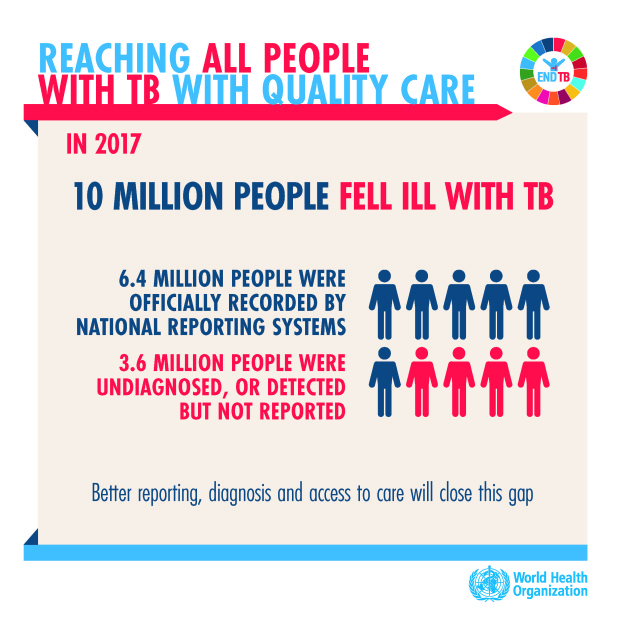
It’s time to Find. Treat. All. How can telemedicine help #EndTB?
Tuberculosis (TB) remains one of the world’s deadliest infectious diseases with over 1 million people losing their lives annually and many more continuing to contract the preventable and curable disease. One third of all TB cases are reported in some of the poorest countries in the world, with the highest reported cases found in India, Indonesia and Nigeria. The World Health Organization (WHO) states that global efforts to combat TB have saved an estimated 53 million lives since 2000 and have reduced the TB mortality rate by 43%1. However, there is still plenty more to be done with persistent gaps remaining in TB care and prevention and stalled progress in many countries. March 24th is World Tuberculosis Day, a day to mark the scientific discovery of Dr Robert Koch in 1882 of Mycobacterium tuberculosis, the bacillus that causes TB. A discovery that revolutionized the diagnosis, treatment, and prevention of TB. The theme of this year’s event is ‘It’s time’ – It’s time to stand up and end this global epidemic1.

WHO have set up the initiative ‘Find. Treat. All. #EndTB’ with an aim to accelerate the response to TB by nations around the world. A large part of this initiative is to ensure access for all to quality care. Importantly, even though a global task force on digital health for TB has been setup, the potential to use telemedicine as a tool to combat TB still remains largely untapped2. Many countries have thus embarked on studying how telemedicine, eHealth, and mHealth may be useful in the fight against TB.
Telemedicine is multi-functional for the awareness and control of TB and the following are three ways to show this:
Improving patient follow-up: There has been a positive implementation of ‘virtual’ clinics and videoconference consultation in remote areas of Canada such as Alberta and Ontario, improving regular access to quality healthcare providers3,4. Additionally, in Mozambique mHealth has been successfully implemented in the form of regular reminder SMS’ to reduce missed appointments and improve the collection of medications5.
Improving patient adherence to treatment: Video direct observed therapy (VDOT) has been successfully tested in countries such as USA (New York City) and Belarus to bridge the gap between patients and healthcare providers and promote adherence to the rigid treatment regime all patients must undertake6,7,8. Furthermore, in South Africa a mHealth application has been developed and used to capture patient data, deliver faster results, and to monitor treatment initiation. It has been highly successful in improving the initial follow up after a positive test to start treatment9.
Improving contact tracing: Contact tracing is essential in disrupting the spread of TB as quickly as possible. In Botswana, a resource-limited country, an mHealth app has been successfully used to track all possibly exposed persons10. Not only did it reduce the time to complete the search, but it also greatly improved the quality of data collected.
When it comes to the large-scale use of telemedicine, a multi-country study published by Konduri et al. in 2017 investigated the implementation and use of e-TB manager, a web-based eHealth system utilized in over 1600 active sites in nine resource-limited countries including Armenia, Bangladesh, Brazil, Cambodia, Indonesia, Namibia, Nigeria, Ukraine, and Vietnam. e-TB manager is operated by healthcare professionals as part of TB surveillance, patient care from diagnosis to medication adherence, monitoring of treatment outcomes as well as management of their supplies. Overall, this study found that all users were satisfied with e-TB manager and confirmed that the system improved TB patient care11.
Globally, the implementation of digital health and telemedicine in the management of TB holds much promise from patient care to public awareness. Ultimately, TB still kills more people than any other infectious disease and there is a growing need to combat it in different ways – telemedicine shows enormous promise in this digitally-growing age.
This World Tuberculosis Day we need to stand and says ‘It’s time’ to #EndTB.
References
1. World Health Organisation. 2019. ‘World Tuberculosis Day 2019’ https://www.who.int/news-room/events/detail/2019/03/24/default-calendar/world-tb-day-2019 Cited on 11/03/2019.
2. Falzon, D., et al. 2017. Digital health to end tuberculosis in the Sustainable Development Goals era: achievements, evidence and future perspectives. Eur Respir J. 50:1701632.
3. Long, R., et al. 2015. Do “Virtual” and “Outpatient” Public Health Tuberculosis Clinics Perform Equally Well? A Program-Wide Evaluation in Alberta, Canada. PloS one. 10(12):e0144784.
4. Mashru, J., et al. 2017. Management of infectious diseases in remote northwestern Ontario with telemedicine videoconference consultations. J Telemedicine and Telecare. 23(1):83–87.
5. Nhavoto, J.A., et al. 2017. Mobile health treatment support intervention for HIV and tuberculosis in Mozambique: Perspectives of patients and healthcare workers. PLoS One. 12(4):e0176051.
6. Lam, C.K., et al. 2018. Using Video Technology to Increase Treatment Completion for Patients with Latent Tuberculosis Infection on 3-Month Isoniazid and Rifapentine: An Implementation Study. J Med Internet Res. 20(11):e287.
7. Chuck, C., et al. 2016. Enhancing management of tuberculosis treatment with video directly observed therapy in New York City. Int J Tuberculosis and Lung Disease. 20(5):588-596.
8. Sinkou, H., et al. 2017. Video-observed treatment for tuberculosis patients in Belarus: findings from the first programmatic experience. Eur Respir J. 49(3):1602049.
9. Maraba, N., et al. 2018. Using mHealth to improve tuberculosis case identification and treatment initiation in South Africa: Results from a pilot study. PLoS One. 13(7):e0199687.
10. Ha, Y.P., et al. 2016. Evaluation of a Mobile Health Approach to Tuberculosis Contact Tracing in Botswana. J Health Commun. 21(10):1115-21.
11. Kondari, H., et al. 2017. User experience analysis of an eHealth system for tuberculosis in resource-constrained settings: A nine-country comparison. Int. J Med Informatics. 102:118-129.

